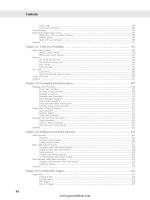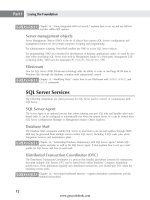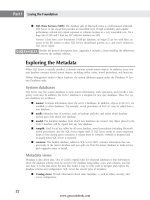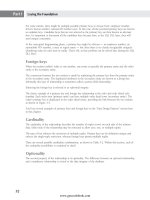Hướng dẫn học Microsoft SQL Server 2008 part 31 potx
Bạn đang xem bản rút gọn của tài liệu. Xem và tải ngay bản đầy đủ của tài liệu tại đây (599.4 KB, 10 trang )
Nielsen c11.tex V4 - 07/23/2009 1:54pm Page 262
Part II Manipulating Data With Select
What’s New with Subqueries?
S
ubqueries are fundamental to SQL and there’s been a steady evolution of their capabilities. Significant
recent improvements include the following:
■ SQL Server 2005 saw the introduction of the Apply structure for user-defined
functions and subqueries.
■ With SQL Server 2008, Microsoft adds row constructors that can be used in the
subquery to provide hard-coded values to the query.
■ Also new with SQL server 2008 is composable SQL — a new way to plug together
multiple DML statements. Anytime there’s a new way to connect together different
parts of the SQL query, it opens new doors for experimentation and building new
queries.
It’s good to see Microsoft continue to evolve and progress in critical areas such as subqueries.
Simple Subqueries
Simple subqueries are executed in the following order:
1. The simple subquery is executed once.
2. The results are passed to the outer query.
3. The outer query is executed once.
The most basic simple subquery returns a single (scalar) value, which is then used as an expression in
the outer query, as follows:
SELECT (SELECT 3) AS SubqueryValue;
Result:
SubqueryValue
3
The subquery (SELECT 3) returns a single value of 3, which is passed to the outer SELECT statement.
The outer
SELECT statement is then executed as if it were the following:
SELECT 3 AS SubqueryValue;
Of course, a subquery with only hard-coded values is of little use. A useful subquery fetches data from a
table, for example:
USE OBXKites;
SELECT ProductName
262
www.getcoolebook.com
Nielsen c11.tex V4 - 07/23/2009 1:54pm Page 263
Including Data with Subqueries and CTEs 11
FROM dbo.Product
WHERE ProductCategoryID
=(Select ProductCategoryID
FROM dbo.ProductCategory
Where ProductCategoryName = ‘Kite’);
To execute this query, SQL Server first evaluates the subquery and returns a value to the outer query
(your unique identifier will be different from the one in this query):
Select ProductCategoryID
FROM dbo.ProductCategory
Where ProductCategoryName = ‘Kite’;
Result:
ProductCategoryID
c38D8113-2BED-4E2B-9ABF-A589E0818069
The outer query then executes as if it were the following:
SELECT ProductName
FROM dbo.Product
WHERE ProductCategoryID
=‘c38D8113-2BED-4E2B-9ABF-A589E0818069’;
Result:
ProductName
Basic Box Kite 21 inch
Dragon Flight
Sky Dancer
Rocket Kite
If you think subqueries seem similar to joins, you’re right. Both are a means of referencing multiple data
sources within a single query, and many queries that use joins may be rewritten as queries using sub-
queries.
Best Practice
U
se a join to pull data from two data sources that can be filtered or manipulated as a whole after the
join. If the data must be manipulated prior to the join, then use a derived table subquery.
263
www.getcoolebook.com
Nielsen c11.tex V4 - 07/23/2009 1:54pm Page 264
Part II Manipulating Data With Select
Common table expressions
The common table expression (CTE) defines what could be considered a temporary view, which can be
referenced just like a view in the same query. Because CTEs may be used in the same ways that simple
subqueries are used and they compile exactly like a simple subquery, I’ve included them in the simple
subquery heading and will show example code CTEs alongside simple subqueries.
The CTE uses the
WITH clause, which defines the CTE. Inside the WITH clause is the name, column
aliases, and SQL code for the CTE subquery. The main query can then reference the CTE as a data
source:
WITH CTEName (Column aliases)
AS (Simple Subquery)
SELECT
FROM CTEName;
The WITH keyword not only begins a CTE, it also adds a hint to a table reference. This is
why the statement before a CTE must be terminated with a semicolon — just one more
reason to always terminate every statement with a semicolon.
The following example is the exact same query as the preceding subquery, only in CTE format. The
name of the CTE is
CTEQuery. It returns the ProductionCategoryID column and uses the exact
same SQL
Select statement as the preceding simple subquery:
WITH CTEQuery (ProductCategoryID)
AS (Select ProductCategoryID
from dbo.ProductCategory
Where ProductCategoryName = ‘Kite’)
(Note that a CTE by itself is an incomplete SQL statement. If you try to run the preceding code, you
will get a syntax error.)
Once the CTE has been defined in the
WITH clause, the main portion of the query can reference the
CTE using its name as if the CTE were any other table source, such as a table or a view. Here’s the
complete example, including the CTE and the main query:
WITH CTEQuery (ProductCategoryID)
AS (Select ProductCategoryID
from dbo.ProductCategory
Where ProductCategoryName = ‘Kite’)
SELECT ProductName
FROM dbo.Product
WHERE ProductCategoryID
= (SELECT ProductCategoryID FROM CTEQuery);
To include multiple CTEs within the same query, define the CTEs in sequence prior to the main query:
WITH
CTE1Name (column names)
AS (Simple Subquery),
264
www.getcoolebook.com
Nielsen c11.tex V4 - 07/23/2009 1:54pm Page 265
Including Data with Subqueries and CTEs 11
CTE2Name (column names)
AS (Simple Subquery)
SELECT
FROM CTE1Name
INNER JOIN CTE2Name
ON
Although CTEs may include complex queries, they come with two key restrictions:
■ Unlike subqueries, CTEs may not be nested. A CTE may not include another CTE.
■ CTEs may not reference the main query. Like simple subqueries, they must be self-contained.
However, a CTE may reference any of the CTEs defined before it, or even itself (see below).
Best Practice
A
lthough the CTE syntax may initially appear alien, for very complex queries that reference the same
subquery in multiple locations, using a CTE may reduce the amount of code and improve readability.
A CTE is really just a different syntax for a simple subquery used as a derived table, with
one key exception: CTEs can recursively refer to the same table using a union, and this
works great for searching an adjacency pairs pattern hierarchy. For more details on using CTEs for
hierarchies, turn to Chapter 17, ‘‘Traversing Hierarchies.’’
Using scalar subqueries
If the subquery returns a single value it may then be used anywhere inside the SQL SELECT statement
where an expression might be used, including column expressions,
JOIN conditions, WHERE conditions,
or
HAVING conditions.
Normal operators (+, =, between, and so on) will work with single values returned from a subquery;
data-type conversion using the
CAST() or CONVERT() functions may be required, however.
The example in the last section used a subquery within a
WHERE condition. The following sample query
uses a subquery within a column expression to calculate the total sales so each row can calculate the
percentage of sales:
SELECT ProductCategoryName,
SUM(Quantity * UnitPrice) AS Sales,
Cast(SUM(Quantity * UnitPrice) /
(SELECT SUM(Quantity * UnitPrice)
FROM dbo.OrderDetail) *100)
AS PercentOfSales
FROM dbo.OrderDetail AS OD
INNER JOIN dbo.Product AS P
ON OD.ProductID = P.ProductID
INNER JOIN dbo.ProductCategory AS PC
265
www.getcoolebook.com
Nielsen c11.tex V4 - 07/23/2009 1:54pm Page 266
Part II Manipulating Data With Select
ON P.ProductCategoryID = PC.ProductCategoryID
GROUP BY ProductCategoryName
ORDER BY Count(*) DESC;
The subquery, SELECT SUM(Quantity * UnitPrice) from OrderDetail, returns a value of
1729.895, which is then passed to the outer query’s PercentageOfSales column. The result lists
the product categories, sales amount, and percentage of sales:
ProductCategoryName Sales PercentOfSales
Kite 1694.452500 87.891300
OBX 64.687500 3.355300
Clothing 117.050000 6.071300
Accessory 10.530000 0.546100
Material 5.265000 0.273000
Video 35.910000 1.862600
The following SELECT statement is extracted from the fsGetPrice() user-defined function in the
OBXKites sample database. The OBXKites database has a Price table that allows each product to
have a list of prices, each with an effective date. The OBX Kite store can predefine several price changes
for a future date, rather than enter all the price changes the night before the new prices go into effect.
As an additional benefit, this data model maintains a price history.
The
fsGetPrice() function returns the correct price for any product, any date, and any customer-
discount type. To accomplish this, the function must determine the effective date for the date submitted.
For example, if a user needs a price for July 16, 2002, and the current price was made effective on July
1, 2002, then in order to look up the price the query needs to know the most recent price date using
max(effectivedate),whereeffectivedate is = @orderdate. Once the subquery determines
the effective date, the outer query can look up the price. Some of the function’s variables are replaced
with static values for the purpose of this example:
SELECT @CurrPrice = Price * (1-@DiscountPercent)
FROM dbo.Price
INNER JOIN dbo.Product
ON Price.ProductID = Product.ProductID
WHERE ProductCode = ‘1001’
AND EffectiveDate =
(SELECT MAX(EffectiveDate)
FROM dbo.Price
INNER JOIN dbo.Product
ON Price.ProductID = Product.ProductID
WHERE ProductCode = ‘1001’
AND EffectiveDate <= ‘2001/6/1’);
Calling the function,
Select dbo.fGetPrice(’1001’,’5/1/2001’,NULL);
266
www.getcoolebook.com
Nielsen c11.tex V4 - 07/23/2009 1:54pm Page 267
Including Data with Subqueries and CTEs 11
the subquery determines that the effective price date is January 5, 2001. The outer query can then find
the correct price based on the
ProductID and effective date. Once the fGetPrice() function calcu-
lates the discount, it can return
@CurrPrice to the calling SELECT statement:
14.95
Using subqueries as lists
Subqueries begin to shine when used as lists. A single value, commonly a column, in the outer query is
compared with the subquery’s list by means of the
IN operator. The subquery must return only a single
column; multiple columns will fail.
The
IN operator returns a value of true if the column value is found anywhere in the list supplied
by the subquery, in the same way that
WHERE IN returns a value of true when used with a
hard-coded list:
SELECT FirstName, LastName
FROM dbo.Contact
WHERE HomeRegion IN (’NC’, ‘SC’, ‘GA’, ‘AL’, ‘VA’);
A list subquery serves as a dynamic means of generating the WHERE IN condition list:
SELECT FirstName, LastName
FROM dbo.Contact
WHERE Region IN (Subquery that returns a list of states);
The following query answers the question ‘‘When OBX Kites sells a kite, what else does it sell with the
kite?’’ To demonstrate the use of subqueries, this query uses only subqueries — no joins. All of these
subqueries are simple queries, meaning that each can run as a stand-alone query.
The subquery will find all orders with kites and pass those
OrderIDs to the outer query. Four tables
are involved in providing the answer to this question:
ProductCategory, Product, OrderDetail,
and
Order. The nested subqueries are executed from the inside out, so they read in the following order
(explained in more detail after the query):
1. The subquery finds the one
ProductCategoryID for the kites.
2. The subquery finds the list of products that are kites.
3. The subquery finds the list of orders with kites.
4. The subquery finds the list of all the products on orders with kites.
5. The outer query finds the product names.
SELECT ProductName
FROM dbo.Product
WHERE ProductID IN
4. Find all the products sold in orders with kites
(SELECT ProductID
267
www.getcoolebook.com
Nielsen c11.tex V4 - 07/23/2009 1:54pm Page 268
Part II Manipulating Data With Select
FROM dbo.OrderDetail
WHERE OrderID IN
3. Find the Kite Orders
(SELECT OrderID Find the Orders with Kites
FROM dbo.OrderDetail
WHERE ProductID IN
2. Find the Kite Products
(SELECT ProductID
FROM dbo.Product
WHERE ProductCategoryID =
1. Find the Kite category
(Select ProductCategoryID
FROM dbo.ProductCategory
Where ProductCategoryName
= ‘Kite’ ) ) ) );
You can highlight any of these subqueries and run it as a stand-alone query in a query win-
dow by selecting just the subquery and pressing F5. Be sure to include the correct number
of closing parentheses.
Subquery 1 finds the ProductCategoryID for the kite category and returns a single value.
Subquery 2 uses subquery 1 as a
WHERE clause expression subquery that returns the kite
ProductCategoryID.UsingthisWHERE clause restriction, subquery 2 finds all products for
which the
ProductCategoryID is equal to the value returned from subquery 2.
Subquery 3 uses subquery 2 as a
WHERE clause list subquery by searching for all OrderDetail rows
that include any one of the
productIDs returned by subquery 2.
Subquery 4 uses subquery 3 as a
WHERE clause list subquery that includes all orders that include kites.
The subquery then locates all
OrderDetail rows for which the orderID is in the list returned by
subquery 3.
The outer query uses subquery 4 as a
WHERE clause list condition and finds all products for which the
ProductID is in the list returned by subquery 4, as follows:
ProductName
Falcon F-16
Dragon Flight
OBX Car Bumper Sticker
Short Streamer
Cape Hatteras T-Shirt
Sky Dancer
Go Fly a Kite T-Shirt
Long Streamer
Rocket Kite
OBX T-Shirt
268
www.getcoolebook.com
Nielsen c11.tex V4 - 07/23/2009 1:54pm Page 269
Including Data with Subqueries and CTEs 11
Drat! There are kites in the list. They’ll have to be eliminated from the query. To fix the error, the outer
query needs to find all the products
WHERE:
■ The
ProductID is IN an order that included a kite
and
■ The
ProductID is NOT IN the list of kites
Fortunately, subquery 2 returns all the kite products. Adding a copy of subquery 2 with the
NOT IN
operator to the outer query will remove the kites from the list, as follows:
SELECT ProductName
FROM dbo.Product
WHERE ProductID IN
4. Find all the products sold in orders with kites
(SELECT ProductID
FROM dbo.OrderDetail
WHERE OrderID IN
3. Find the Kite Orders
(SELECT OrderID Find the Orders with Kites
FROM dbo.OrderDetail
WHERE ProductID IN
2. Find the Kite Products
(SELECT ProductID
FROM dbo.Product
WHERE ProductCategoryID =
1. Find the Kite category
(Select ProductCategoryID
FROM dbo.ProductCategory
Where ProductCategoryName
= ‘Kite’))))
outer query continued
AND ProductID NOT IN
(SELECT ProductID
FROM dbo.Product
WHERE ProductCategoryID =
(Select ProductCategoryID
FROM dbo.ProductCategory
Where ProductCategoryName
= ‘Kite’));
Result:
ProductName
OBX Car Bumper Sticker
Short Streamer
269
www.getcoolebook.com
Nielsen c11.tex V4 - 07/23/2009 1:54pm Page 270
Part II Manipulating Data With Select
Cape Hatteras T-Shirt
Go Fly a Kite T-Shirt
Long Streamer
OBX T-Shirt
For comparison purposes, the following queries answer the exact same question but are written with
joins. The
Product table is referenced twice, so the second reference that represents only the kites has
an alias
Kite. As with the previous subqueries, the first version of the query locates all products and
the second version eliminates the kites:
SELECT Distinct P.ProductName
FROM dbo.Product AS P
JOIN dbo.OrderDetail AS OrderRow
ON P.ProductID = OrderRow.ProductID
JOIN dbo.OrderDetail AS KiteRow
ON OrderRow.OrderID = KiteRow.OrderID
JOIN dbo.Product AS Kite
ON KiteRow.ProductID = Kite.ProductID
JOIN dbo.ProductCategory AS PC
ON Kite.ProductCategoryID
= PC.ProductCategoryID
WHERE PC.ProductCategoryName = ‘Kite’;
The only change necessary to eliminate the kites is the addition of another condition to the
ProductCategory join. Previously, the join was an equi-join between Product and
ProductCategory. Adding a -join condition of <> between the Product table and the
ProductCategory table removes any products that are kites, as shown here:
SELECT Distinct P.ProductName
FROM dbo.Product AS P
JOIN dbo.OrderDetail AS OrderRow
ON P.ProductID = OrderRow.ProductID
JOIN dbo.OrderDetail AS KiteRow
ON OrderRow.OrderID = KiteRow.OrderID
JOIN dbo.Product AS Kite
ON KiteRow.ProductID = Kite.ProductID
JOIN dbo.ProductCategory AS PC
ON Kite.ProductCategoryID
= PC.ProductCategoryID
AND P.ProductCategoryID
<> Kite.ProductCategoryID
Where PC.ProductCategoryName = ‘Kite’;
270
www.getcoolebook.com
Nielsen c11.tex V4 - 07/23/2009 1:54pm Page 271
Including Data with Subqueries and CTEs 11
Best Practice
S
QL is very flexible — there are often a dozen ways to express the same question. Your choice of SQL
method should be made first according to your style and to which method enables you to be readable and
logically correct, and then according to performance considerations. Test the actual queries for performance
but keep in mind that slow and correct beats fast and wrong every time.
Using subqueries as tables
In the same way that a view may be used in the place of a table within the FROM clause of a SELECT
statement, a subquery in the form of a derived table can replace any table, provided the subquery has
an alias. This technique is very powerful and is often used to break a difficult query problem down into
smaller bite-size chunks.
Using a subquery as a derived table is an excellent solution to the aggregate-function problem. When
you are building an aggregate query, every column must participate in the aggregate function in some
way, either as a
GROUP BY column or as an aggregate function (sum(), avg(), count(), max(),or
min()). This stipulation makes returning additional descriptive information difficult. However, perform-
ing the aggregate functions in a subquery and passing the rows found to the outer query as a derived
table enables the outer query to then return any columns desired.
For more information about aggregate functions and the group by keyword, see Chapter
12, ‘‘Aggregating Data.’’
The question ‘‘How many of each product have been sold?’’ is easy to answer if only one column from
the
Product table is included in the result:
SELECT P.Code, SUM(Quantity) AS QuantitySold
FROM dbo.OrderDetail AS OD
JOIN dbo.Product AS P
ON OD.ProductID = P.ProductID
GROUP BY P.Code
ORDER BY P.Code;
Result:
Code QuantitySold
1002 47.00
1003 5.00
1004 2.00
1012 5.00
271
www.getcoolebook.com









